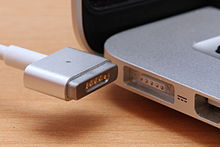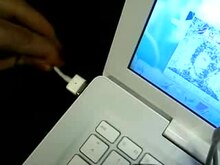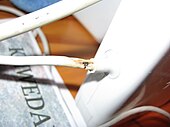MagSafe
MagSafe is the name of the proprietary power supply connector for notebooks made by Apple . It was presented on January 10, 2006 together with the MacBook Pro at the Macworld Expo and has since been installed in the MacBook Pro, MacBook Air and in MacBook models sold before 2015 . The primary goal of this quick-release connector is to avoid falling accidents in connection with tripping over the power supply cable .
As of June 2012, Apple will be installing a flatter connector called MagSafe 2 to reduce the thickness of the MacBook Pro and MacBook Air. These two types are - purely geometrically - incompatible.
With the renewal of the MacBook Pro in October 2016, the MagSafe connection was also replaced by USB-C , whereby the trip protection is no longer given.
Layout and function
The plug is held in the associated socket by means of a permanent magnet which is arranged in a ring around the contacts. The power supply connector is not plugged in as with normal connectors , but inserted into a shallow recess on the notebook and held there by a permanent magnet covered with a thin plastic layer. The current-carrying, spring-loaded and gold-plated contacts on the cable side are brought into contact with those of the socket and pressed on slightly with a spring-loaded action. With a strong pull on the cable, no matter in which direction, the connection loosens and thus eliminates the risk of accidents with usually greater damage, in which a computer with a stuck, plugged-in cable would be torn from the table. The reduced risk of accidents does not apply to the L-shaped design.
This construction also prevents the power socket on the inside of the computer board from breaking out and causing a loose connection. With conventional connectors, this can happen if the plug is tilted on the outside, and it happens in particular if the plug is not removed before packing a notebook into a bag. The plug connection suffers a similar situation when the notebook is operated on a soft surface on which the device sinks, but the plug does not in the same way.
The rectangular connector is symmetrical, so it can be inserted in both directions. On the side of the connector there are light-emitting diodes that indicate the status of the charging process: orange means charging, green means no charging process. The connector system is only suitable for extra-low voltages due to the contacts, which are located in a recess, but are quite open .
The light-emitting diodes do not necessarily light up when charging current flows - as was the case with early battery chargers, where they were directly in the electrical circuit. Dark diodes can be caused by a fault in the center contact and the device's power supply may still work.
Patent and kinship
Apple holds a patent on this magnetic connector. A similar construction was previously used in various kitchen appliances. In August 2011, it was announced that Apple had applied for a patent for a MagSafe connector for the iPad . As is usual with Apple patents, however, it was never implemented in series devices; a magnetic connection for power supply can only be found on MacBooks up to 2016.
power adapter
The power supply unit with the MagSafe plug has the permanently attached MagSafe cable on the secondary side and a changeable, country-specific power plug on the primary side. In continental Europe, the MagSafe power supply unit comes with a small Euro plug and a long connection cable with a plug with protective contact , in Germany and Austria a Schuko plug , in Switzerland a T12 plug according to SEV 1011 . It has been sold by Apple in various electrical performance levels, depending on the notebook model.
Pin assignment
The connection has five pins that are linear and symmetrical about the center. The middle pin (3) is used to control the LEDs on the connector. The positive pole with approx. 14.5 V to 20 V depending on the model is located on the inner pins (2) and (4). On the very outside the ground connection (1) and (5). The outer metal edge is used for the magnetic connection and also for electrical shielding .
A serial data line is connected via the connector in order to exchange power supply data and to control the LEDs. The chip for this is located in the MagSafe connector itself. The serial number and the power of the power supply unit can be read out via the MacBook; this information is located in the chip of the MagSafe connector.
Weak points
In 2007, Apple had to call back the power adapters because there were repeated cable breaks . Some of the cables were so thin that cable fires started at these points and the plastic insulation melted. Apple then improved the mechanical strength and conductor routing. The computer magazine c't describes the problems as "predetermined breaking points" and there are numerous instructions on the Internet on how to repair the device yourself with a soldering iron if the warranty has expired. However, the problems do not affect the connector system itself, but rather the insufficiently dimensioned cable feed.
photos
Web links
Individual evidence
- ↑ Macrumors.com: Retina Display MacBook Pro and New MacBook Air Includes Thinner MagSafe 2 Power Port. June 11, 2012, accessed May 5, 2014.
- ↑ Apple's MagSafe patent
- ↑ 'Break-away' cord aims to make deep fryers safer ( memento of April 25, 2011 in the Internet Archive ) on the CNN pages in the Internet Archive
- ↑ New Apple patents: MagSafe connector for the iPad
- ↑ See report at AppleInsider .
- ↑ See report at AppleInsider about the redesign.
- ↑ Article in the magazine c't.









